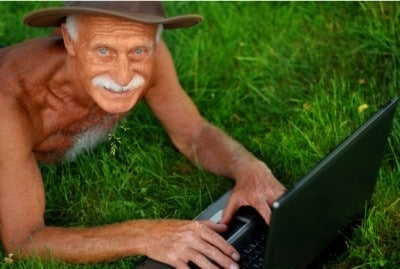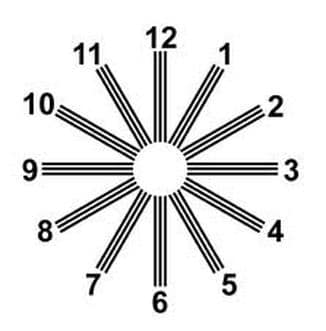Even those of us who are fluent in naturopathic medicine may not have extended this paradigm to our eyesight yet. We may still think corrective lenses or surgery are the only ways to improve our eyesight. Fortunately, we now have many options to cure the causes of our poor eyesight rather than just masking the symptom with lenses.
My vision was great until I went to university. Peeking through the dimly lit lecture hall with 300 students and seeing the text on the foil projected onto the wall ruined my distant view. I also noticed that my night vision has also decreased significantly.
I got glasses for when I really needed them – when I couldn’t sit in the front of the class or drive late at night because my fatigue made my vision worse – but I tried to keep them as little as possible to use. My father is an optician and he told me that the more you rely on glasses, the weaker your eye muscles become and the more you have to wear your glasses!
Well, in recent years, the Bates Method of improving eyesight through a combination of relaxation and strengthening exercises has become increasingly popular. With many spin-offs offering a specialized version of this and therapists trained to guide you through the process – you teach, guide and keep you on track just like a personal trainer.
First, take a look at some lifestyle factors that you can get used to on a daily basis – these are the things you should do, even if you have good eyesight, to maintain your eye health.
Simple things to do to maintain and improve eye health
Here are some simple things you can do by natural vision experts to make a part of your normal life, such as brushing your teeth:
- Do not use sunglasses except during intense activities such as skiing or boating. There are 1200 wavelengths in sunlight that nourish the eye. So wear a cap / hat that will shade your eyes but don’t cover them with sunglasses.
- Don’t blink to see better. Instead, blink your eyes quickly to relieve tension. Tension around the eyes, neck, and shoulders is a major cause of vision deterioration. So be aware and use quick blinking to relieve tension and you will be able to see better without blinking. what is harmful. I always remember my dad yelling at me, “Stop blinking!”
- Do not enlarge the font on your computer screen, etc., to make it easier to see. Blink and use eye exercises instead.
- Lower the brightness on all of your screens; Cell phones, computer monitors, iPads, etc. to protect your eyes. A great app for this (and the one I use) is Flux, which automatically adjusts the brightness and hue of your monitor based on the time of day. This also makes your circadian rhythm easier.
- Do not stare at a phone or small device near your face for more than a few minutes or you may have trouble seeing clearly from a distance. even a short distance. This is also not a good idea because of the radiation exposure!
- Yawn as much as possible in front of your screen or when you have poor vision – this will relax your eyes, increase oxygen and blood flow.
 Okay, so now you have a few simple tips that you can incorporate seamlessly into your everyday life – all you have to do is remember to do them!
Okay, so now you have a few simple tips that you can incorporate seamlessly into your everyday life – all you have to do is remember to do them!
Let’s get to some of the simpler – but still very effective – eye exercises that you can do on your own without a teacher.
Unless your vision problems are severe, you will likely see a great improvement from doing these exercises on your own. For more solid or more severe vision problems, you will likely need to see a Bates method teacher.
Simple exercises to improve your eyesight
1. Palming – Rub your palms together briskly to warm them up if necessary. Cover your eyes completely (do not press your eyeballs) with your palms and close your eyes. Relax. Aim for 3 minutes of the ball of your hand, then pause, then another 3 minutes of the heel of your hand, pause, then another 3 minutes.
2. Sunbathing or sunbathing – Turn your face towards the sun, close your eyes and gently move your head from side to side for as long as it feels good. If you live in a very hot climate, do so closer to sunrise or sunset. If it’s a very bright sunny day, do this exercise between 8-10 a.m. or 4-7 p.m.
3. Near-to-far shift – This is demonstrated in the video below. Go out. Start with your right eye open and cover your left eye. Focus on your thumb in front of your face for 10 seconds, then focus on the object farthest away from you (a mountain top, a distant tree, etc.) for 10 seconds. Keep your thumb pointed up in front of your face when switching to the distant object – you want to force your eyes to ignore the nearby object and focus on the distant object instead. Repeat 15 times. Then do the same thing with your left eye and repeat 15 times. Then cover both eyes and focus your sight on your thumb for 10 seconds, then on the distant object for 10 seconds. Repeat 20 times. It is normal to see 2 thumbs when you focus on the distant object with both eyes (even if you only hold 1 thumb). You have the sun behind you – so you don’t look into the sun.
4. Massage and / or tap around your eye sockets (affects sympathetic nerves and acupuncture points) – your eye socket is the circle of bones that surrounds your eyeball. Simply tap the bone comfortably with your fingertips or massage all around. Hey, another good reason to do EFT tapping!
Here is a good video demonstration of the first 3 exercises, and remember that these work equally well for farsightedness OR nearsightedness:
Note: He’s pretty strong with the bolsters – maybe you need to be gentler!
If you want a more scientific approach to improving your eyesight, here is a great presentation from Todd Becker MS. If you spend a lot of time at the computer, this method may work better for you:
And astigmatism?
If you’ve never seen an optometrist before, you probably don’t know whether or not you have astigmatism (an irregularly shaped cornea or lens).
But here’s an easy way to check:

Remove any glasses or contact lenses.
Cover your right eye with your hand and look at this numbered wheel with your left eye.
If some of the spokes appear darker and others appear lighter, you have astigmatism in that eye.
Do the same with your other eye.
You can also use this astigmatism wheel to improve your eyesight by doing astigmatism exercises with it!
Originally posted April 2016. Last updated May 2021.
![]()
Jini Patel Thompson is an internationally recognized expert in naturopathic treatments for digestive diseases. She healed herself from the widespread Crohn’s disease and has been drug and surgery free for over 20 years. Appeared on numerous podcast, television and radio shows in the US, UK, Canada and Australia, Jini gives people hope and visions on how to cure colitis, Crohn’s disease, diverticulitis and irritable bowel syndrome (IBS) in all natural methods. Her books on natural digestive disease cures have been sold in over 80 countries around the world.


